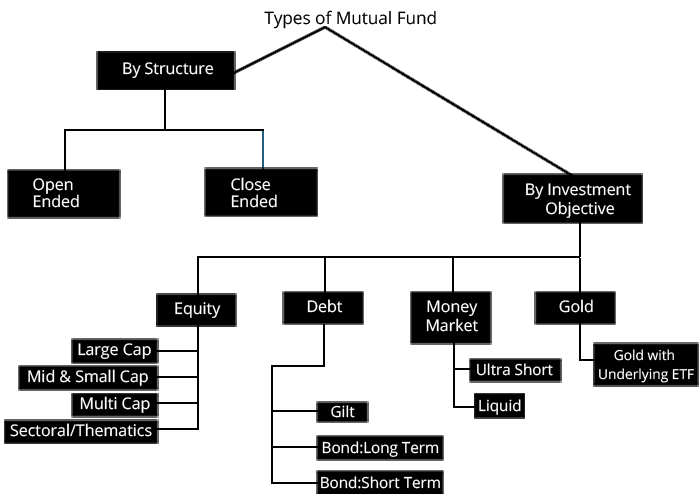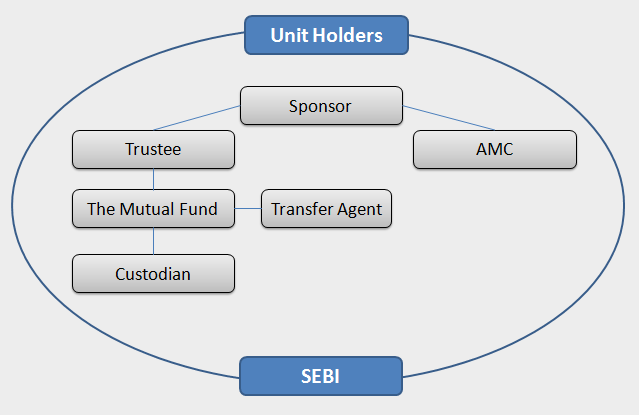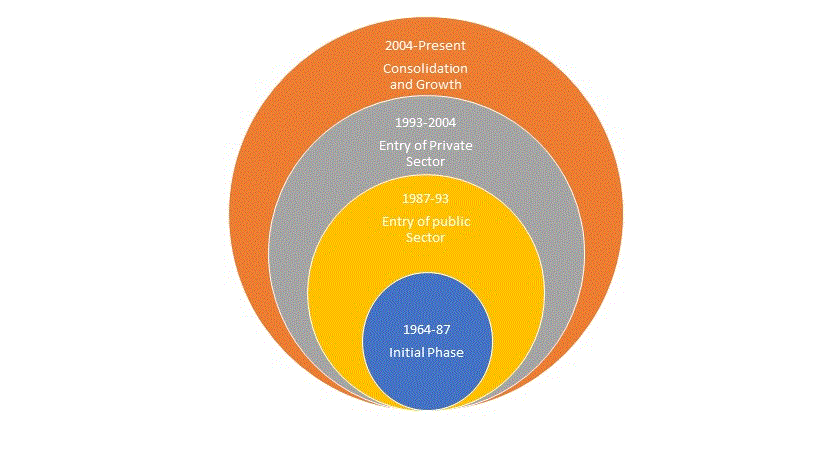Types of Mutual Funds in India
The Mutual Fund industry has been in India since 1963. Today, there are more than 10,000 schemes that exist in India, and growth of the industry has been massive. The AUM of the Indian MF Industry has grown from ₹7.66 trillion as on August 31, 2013 to ₹46.63 trillion as on August 31, 2023 more than 6 fold increase in a span of 10 years. To add, the total number of folios as per MF parlance as on April 30, 20213 stood at 15.42 crore (154.2 million)
Looking at such eye-tempting growth, many people are attracted to invest, which is a great step for securing the future. Before you start, ensure your research well. It is important to know the basics of MFs such as types of Mutual Funds, risk & return, diversification, etc. MFs deploy money by investing in the stock market for equities, they also take exposure to debt instruments. Likewise, they also invest in gold, hybrid, FOFs, etc. The basics classification is by maturity period, where there are two broad categories of mutual funds - open-ended and closed-ended.
Open-ended Mutual Funds
The majority of mutual funds in India are open-ended in nature. These funds are open for subscription (or in simple terms purchase) by investors at any time. They issue new units to investors who want to get into the fund. After the initial offering period (NFO), the units of these funds can be purchased. In a rare scenario, the Asset Management Company (AMC) can stop further purchase by investors if the AMC feels that there are not enough and good opportunities to deploy the fresh monies. However, for redemption, the AMC has to buy back the units.
Talk to our investment specialist
Closed-ended Mutual Funds
These are funds that are closed for further subscription (or purchase) by investors after the initial offering period (NFO). Unlike, Open-ended funds, investors cannot buy fresh units of these types of mutual funds after the NFO period. Hence, investing in closed-ended funds is possible only during the NFO period. Also, one thing to note is that investors cannot exit via redemption in the closed-ended fund. The redemption takes place once the period matures. Additionally, to provide an opportunity to exit, Mutual Fund Houses list the closed-ended funds on the stock exchange. Hence, investors would need to trade the closed-ended funds on the exchange to exit them before the maturity period.

Different Types of Mutual Funds
Guided by Securities and Exchange Board of India (SEBI) norms, there are five main broad categories and 36 sub-categories in Mutual Funds.
1. Equity Mutual Funds
Equity Funds make money for investors by investing in the equity stock market. This option is suitable for investors looking for long-term returns. Some of the types of equity mutual funds are-
- Large cap funds
- mid cap funds
- Small cap funds
- Sector/thematic funds
- ELSS
- dividend yield funds
- focused fund
Fund NAV Net Assets (Cr) 3 MO (%) 6 MO (%) 1 YR (%) 3 YR (%) 5 YR (%) 2024 (%) ICICI Prudential Infrastructure Fund Growth ₹200.81
↑ 1.96 ₹8,160 3.2 0.8 6.7 25.4 30.8 6.7 SBI PSU Fund Growth ₹34.6031
↑ 0.60 ₹5,763 7.2 6.8 12.1 28.8 29.6 11.3 Invesco India PSU Equity Fund Growth ₹67.34
↑ 0.98 ₹1,445 5.4 3.2 10.9 29.2 27.9 10.3 HDFC Infrastructure Fund Growth ₹48.234
↑ 0.55 ₹2,514 1.5 -0.1 2.7 25.2 27.6 2.2 Motilal Oswal Midcap 30 Fund Growth ₹99.6925
↑ 0.62 ₹38,003 -0.3 -5.2 -12.6 25.3 27.5 -12.1 Note: Returns up to 1 year are on absolute basis & more than 1 year are on CAGR basis. as on 2 Jan 26 Research Highlights & Commentary of 5 Funds showcased
Commentary ICICI Prudential Infrastructure Fund SBI PSU Fund Invesco India PSU Equity Fund HDFC Infrastructure Fund Motilal Oswal Midcap 30 Fund Point 1 Upper mid AUM (₹8,160 Cr). Lower mid AUM (₹5,763 Cr). Bottom quartile AUM (₹1,445 Cr). Bottom quartile AUM (₹2,514 Cr). Highest AUM (₹38,003 Cr). Point 2 Oldest track record among peers (20 yrs). Established history (15+ yrs). Established history (16+ yrs). Established history (17+ yrs). Established history (11+ yrs). Point 3 Top rated. Rating: 2★ (bottom quartile). Rating: 3★ (upper mid). Rating: 3★ (lower mid). Rating: 3★ (bottom quartile). Point 4 Risk profile: High. Risk profile: High. Risk profile: High. Risk profile: High. Risk profile: Moderately High. Point 5 5Y return: 30.83% (top quartile). 5Y return: 29.64% (upper mid). 5Y return: 27.87% (lower mid). 5Y return: 27.63% (bottom quartile). 5Y return: 27.52% (bottom quartile). Point 6 3Y return: 25.37% (lower mid). 3Y return: 28.82% (upper mid). 3Y return: 29.25% (top quartile). 3Y return: 25.15% (bottom quartile). 3Y return: 25.28% (bottom quartile). Point 7 1Y return: 6.68% (lower mid). 1Y return: 12.07% (top quartile). 1Y return: 10.88% (upper mid). 1Y return: 2.66% (bottom quartile). 1Y return: -12.59% (bottom quartile). Point 8 Alpha: 0.00 (top quartile). Alpha: -0.83 (bottom quartile). Alpha: -0.45 (lower mid). Alpha: 0.00 (upper mid). Alpha: -11.47 (bottom quartile). Point 9 Sharpe: 0.00 (lower mid). Sharpe: 0.03 (upper mid). Sharpe: 0.06 (top quartile). Sharpe: -0.15 (bottom quartile). Sharpe: -0.40 (bottom quartile). Point 10 Information ratio: 0.00 (upper mid). Information ratio: -0.53 (bottom quartile). Information ratio: -0.49 (bottom quartile). Information ratio: 0.00 (lower mid). Information ratio: 0.21 (top quartile). ICICI Prudential Infrastructure Fund
SBI PSU Fund
Invesco India PSU Equity Fund
HDFC Infrastructure Fund
Motilal Oswal Midcap 30 Fund
Large-cap funds invest in companies which have a large market capitalization (hence the name large-), usually, these are very large companies and are established players, e.g Unilever, Reliance, ITC etc. Mid-cap and small-cap funds invest in smaller companies, these companies by being smaller can show extraordinary growth and provide good returns. However, since they are small they can give losses and are riskier.
Thematic funds invest into a particular sector like infrastructure, power, media & entertainment etc. Not all mutual funds provide thematic funds, for e.g Reliance Mutual Fund provides exposure to thematic funds via its Power Sector Fund, Media and Entertainment Fund etc. ICICI Prudential Mutual Fund provides exposure to Banking & financial services sector via its ICICI Prudential Banking & Financial Services Fund, technology via the ICICI Prudential Technology Fund.
2. Debt Mutual Funds
Debt fund invest in fixed income instruments, also known as Bonds & gilts. Bonds funds are classified by their maturity period (hence the name, long term or short term). As per tenure, the risk also varies. The broad categories of debt mutual funds, such as:
- Overnight funds
- Liquid Funds
- Ultra short term funds
- Money market funds
- Dynamic bonds
- Corporate bonds
- Gilt Funds
- Credit risk funds
- Floater fund
Fund NAV Net Assets (Cr) 3 MO (%) 6 MO (%) 1 YR (%) 3 YR (%) 5 YR (%) 2024 (%) DSP Credit Risk Fund Growth ₹50.8152
↓ -0.01 ₹209 1.2 2.1 21 14.7 11.1 21 Franklin India Ultra Short Bond Fund - Super Institutional Plan Growth ₹34.9131
↑ 0.04 ₹297 1.3 5.9 13.7 8.8 8.7 Aditya Birla Sun Life Credit Risk Fund Growth ₹23.3375
↑ 0.00 ₹1,096 1.9 4.2 13.5 10.8 9.1 13.4 Sundaram Short Term Debt Fund Growth ₹36.3802
↑ 0.01 ₹362 0.8 11.4 12.8 5.3 5.6 Sundaram Low Duration Fund Growth ₹28.8391
↑ 0.01 ₹550 1 10.2 11.8 5 5.7 Note: Returns up to 1 year are on absolute basis & more than 1 year are on CAGR basis. as on 2 Jan 26 Research Highlights & Commentary of 5 Funds showcased
Commentary DSP Credit Risk Fund Franklin India Ultra Short Bond Fund - Super Institutional Plan Aditya Birla Sun Life Credit Risk Fund Sundaram Short Term Debt Fund Sundaram Low Duration Fund Point 1 Bottom quartile AUM (₹209 Cr). Bottom quartile AUM (₹297 Cr). Highest AUM (₹1,096 Cr). Lower mid AUM (₹362 Cr). Upper mid AUM (₹550 Cr). Point 2 Established history (22+ yrs). Established history (18+ yrs). Established history (10+ yrs). Oldest track record among peers (23 yrs). Established history (18+ yrs). Point 3 Top rated. Rating: 1★ (bottom quartile). Not Rated. Rating: 2★ (upper mid). Rating: 2★ (lower mid). Point 4 Risk profile: Moderate. Risk profile: Moderate. Risk profile: Moderate. Risk profile: Moderately Low. Risk profile: Moderately Low. Point 5 1Y return: 21.04% (top quartile). 1Y return: 13.69% (upper mid). 1Y return: 13.46% (lower mid). 1Y return: 12.83% (bottom quartile). 1Y return: 11.79% (bottom quartile). Point 6 1M return: 0.26% (bottom quartile). 1M return: 0.59% (top quartile). 1M return: 0.34% (upper mid). 1M return: 0.20% (bottom quartile). 1M return: 0.28% (lower mid). Point 7 Sharpe: 1.55 (lower mid). Sharpe: 2.57 (top quartile). Sharpe: 2.11 (upper mid). Sharpe: 0.98 (bottom quartile). Sharpe: 0.99 (bottom quartile). Point 8 Information ratio: 0.00 (top quartile). Information ratio: 0.00 (upper mid). Information ratio: 0.00 (lower mid). Information ratio: 0.00 (bottom quartile). Information ratio: 0.00 (bottom quartile). Point 9 Yield to maturity (debt): 7.10% (upper mid). Yield to maturity (debt): 0.00% (bottom quartile). Yield to maturity (debt): 7.62% (top quartile). Yield to maturity (debt): 4.52% (lower mid). Yield to maturity (debt): 4.19% (bottom quartile). Point 10 Modified duration: 2.38 yrs (bottom quartile). Modified duration: 0.00 yrs (top quartile). Modified duration: 2.30 yrs (bottom quartile). Modified duration: 1.20 yrs (lower mid). Modified duration: 0.47 yrs (upper mid). DSP Credit Risk Fund
Franklin India Ultra Short Bond Fund - Super Institutional Plan
Aditya Birla Sun Life Credit Risk Fund
Sundaram Short Term Debt Fund
Sundaram Low Duration Fund
3. Hybrid Mutual Funds
Hybrid funds are a type of mutual fund that invests both in equity and debt. They can be Balanced Fund or Monthly Income Plan (MIPs). The portion of investment is higher in equities. Some of the types of hybrid funds are:
- Arbitrage funds
- Dynamic Asset Allocation
- Conservative hybrid funds
- Balanced hybrid funds
Fund NAV Net Assets (Cr) 3 MO (%) 6 MO (%) 1 YR (%) 3 YR (%) 5 YR (%) 2024 (%) UTI Multi Asset Fund Growth ₹79.6601
↑ 0.48 ₹6,551 6.3 6.4 9.7 20.1 15.1 11.1 ICICI Prudential Multi-Asset Fund Growth ₹819.803
↓ -0.78 ₹75,067 5.1 7.7 18 19.5 21.8 18.6 ICICI Prudential Equity and Debt Fund Growth ₹414.8
↑ 3.14 ₹49,223 3.9 5.3 12.4 19.5 22.1 13.3 BOI AXA Mid and Small Cap Equity and Debt Fund Growth ₹38.86
↑ 0.25 ₹1,321 2.9 0.3 -1.6 18.5 19.6 -0.9 SBI Multi Asset Allocation Fund Growth ₹65.7702
↑ 0.32 ₹12,466 7.4 10 18.2 18.4 14.8 18.6 Note: Returns up to 1 year are on absolute basis & more than 1 year are on CAGR basis. as on 2 Jan 26 Research Highlights & Commentary of 5 Funds showcased
Commentary UTI Multi Asset Fund ICICI Prudential Multi-Asset Fund ICICI Prudential Equity and Debt Fund BOI AXA Mid and Small Cap Equity and Debt Fund SBI Multi Asset Allocation Fund Point 1 Bottom quartile AUM (₹6,551 Cr). Highest AUM (₹75,067 Cr). Upper mid AUM (₹49,223 Cr). Bottom quartile AUM (₹1,321 Cr). Lower mid AUM (₹12,466 Cr). Point 2 Established history (17+ yrs). Established history (23+ yrs). Oldest track record among peers (26 yrs). Established history (9+ yrs). Established history (20+ yrs). Point 3 Rating: 1★ (bottom quartile). Rating: 2★ (lower mid). Top rated. Not Rated. Rating: 4★ (upper mid). Point 4 Risk profile: Moderately High. Risk profile: Moderately High. Risk profile: Moderately High. Risk profile: Moderately High. Risk profile: Moderate. Point 5 5Y return: 15.11% (bottom quartile). 5Y return: 21.79% (upper mid). 5Y return: 22.07% (top quartile). 5Y return: 19.65% (lower mid). 5Y return: 14.80% (bottom quartile). Point 6 3Y return: 20.06% (top quartile). 3Y return: 19.55% (upper mid). 3Y return: 19.50% (lower mid). 3Y return: 18.45% (bottom quartile). 3Y return: 18.44% (bottom quartile). Point 7 1Y return: 9.73% (bottom quartile). 1Y return: 18.04% (upper mid). 1Y return: 12.42% (lower mid). 1Y return: -1.62% (bottom quartile). 1Y return: 18.25% (top quartile). Point 8 1M return: 0.81% (bottom quartile). 1M return: 0.85% (lower mid). 1M return: 0.64% (bottom quartile). 1M return: 2.29% (upper mid). 1M return: 2.41% (top quartile). Point 9 Alpha: 0.00 (upper mid). Alpha: 0.00 (lower mid). Alpha: 4.08 (top quartile). Alpha: 0.00 (bottom quartile). Alpha: 0.00 (bottom quartile). Point 10 Sharpe: 0.48 (bottom quartile). Sharpe: 1.32 (top quartile). Sharpe: 0.65 (lower mid). Sharpe: -0.30 (bottom quartile). Sharpe: 1.17 (upper mid). UTI Multi Asset Fund
ICICI Prudential Multi-Asset Fund
ICICI Prudential Equity and Debt Fund
BOI AXA Mid and Small Cap Equity and Debt Fund
SBI Multi Asset Allocation Fund
4. Solution Oriented Schemes
Solution oriented schemes are helpful for those investors who wish to create long-term wealth that mainly includes Retirement planning and a child’s future education by investing in Mutual Funds. Earlier, these plans were a part of equity or balanced schemes, but as per SEBI’s new circulation, these funds are separately categorised under solution oriented schemes. Also these schemes used to have a lock-in for three years, but now these funds have a mandatory lock-in of five years.
Fund NAV Net Assets (Cr) 3 MO (%) 6 MO (%) 1 YR (%) 3 YR (%) 5 YR (%) 2024 (%) HDFC Retirement Savings Fund - Equity Plan Growth ₹52.141
↑ 0.25 ₹7,055 3.6 1.7 4 18 20.6 5.2 ICICI Prudential Child Care Plan (Gift) Growth ₹333.38
↑ 1.66 ₹1,424 2 -0.8 7.3 17.8 16 8.3 HDFC Retirement Savings Fund - Hybrid - Equity Plan Growth ₹39.728
↑ 0.17 ₹1,748 3.1 1.5 4.5 14.5 14.4 5.4 Tata Retirement Savings Fund - Progressive Growth ₹65.4938
↑ 0.23 ₹2,129 2.5 -2.6 -3 15.7 12.8 -1.2 Tata Retirement Savings Fund-Moderate Growth ₹64.9898
↑ 0.18 ₹2,191 2.5 -1.2 -0.6 14.7 12.3 1 Note: Returns up to 1 year are on absolute basis & more than 1 year are on CAGR basis. as on 2 Jan 26 Research Highlights & Commentary of 5 Funds showcased
Commentary HDFC Retirement Savings Fund - Equity Plan ICICI Prudential Child Care Plan (Gift) HDFC Retirement Savings Fund - Hybrid - Equity Plan Tata Retirement Savings Fund - Progressive Tata Retirement Savings Fund-Moderate Point 1 Highest AUM (₹7,055 Cr). Bottom quartile AUM (₹1,424 Cr). Bottom quartile AUM (₹1,748 Cr). Lower mid AUM (₹2,129 Cr). Upper mid AUM (₹2,191 Cr). Point 2 Established history (9+ yrs). Oldest track record among peers (24 yrs). Established history (9+ yrs). Established history (14+ yrs). Established history (14+ yrs). Point 3 Not Rated. Rating: 2★ (lower mid). Not Rated. Top rated. Rating: 5★ (upper mid). Point 4 Risk profile: Moderately High. Risk profile: Moderately High. Risk profile: Moderately High. Risk profile: Moderately High. Risk profile: Moderately High. Point 5 5Y return: 20.61% (top quartile). 5Y return: 15.96% (upper mid). 5Y return: 14.44% (lower mid). 5Y return: 12.83% (bottom quartile). 5Y return: 12.26% (bottom quartile). Point 6 3Y return: 18.05% (top quartile). 3Y return: 17.82% (upper mid). 3Y return: 14.49% (bottom quartile). 3Y return: 15.66% (lower mid). 3Y return: 14.75% (bottom quartile). Point 7 1Y return: 4.01% (lower mid). 1Y return: 7.33% (top quartile). 1Y return: 4.54% (upper mid). 1Y return: -2.99% (bottom quartile). 1Y return: -0.57% (bottom quartile). Point 8 1M return: 0.90% (top quartile). 1M return: 0.59% (lower mid). 1M return: 0.69% (upper mid). 1M return: -0.26% (bottom quartile). 1M return: -0.21% (bottom quartile). Point 9 Alpha: -1.82 (bottom quartile). Alpha: 0.00 (top quartile). Alpha: 0.00 (upper mid). Alpha: -5.96 (bottom quartile). Alpha: 0.00 (lower mid). Point 10 Sharpe: -0.06 (upper mid). Sharpe: 0.16 (top quartile). Sharpe: -0.14 (lower mid). Sharpe: -0.26 (bottom quartile). Sharpe: -0.21 (bottom quartile). HDFC Retirement Savings Fund - Equity Plan
ICICI Prudential Child Care Plan (Gift)
HDFC Retirement Savings Fund - Hybrid - Equity Plan
Tata Retirement Savings Fund - Progressive
Tata Retirement Savings Fund-Moderate
5. Gold Funds
The Gold mutual funds invest in gold ETFs (exchange-traded funds). Ideally suitable for investor who wants to take exposure in gold. Unlike physical gold, they are easy to purchase and redeem (buying and selling). Also, they offer transparency of price for investors for buying and selling.
Fund NAV Net Assets (Cr) 3 MO (%) 6 MO (%) 1 YR (%) 3 YR (%) 5 YR (%) 2024 (%) SBI Gold Fund Growth ₹39.4754
↑ 0.52 ₹9,324 14.5 37.9 73.1 33.3 20.5 71.5 ICICI Prudential Regular Gold Savings Fund Growth ₹41.7003
↑ 0.45 ₹3,987 14 37.6 72.6 33 20.3 72 Axis Gold Fund Growth ₹39.2151
↑ 0.51 ₹1,954 13.5 37.6 71.8 33 20.4 69.8 IDBI Gold Fund Growth ₹34.9686
↑ 0.22 ₹524 11.6 37 72.7 32.9 20.6 79 Nippon India Gold Savings Fund Growth ₹51.5377
↑ 0.60 ₹4,849 14.4 37.6 72.4 32.9 20.2 71.2 Note: Returns up to 1 year are on absolute basis & more than 1 year are on CAGR basis. as on 2 Jan 26 Research Highlights & Commentary of 5 Funds showcased
Commentary SBI Gold Fund ICICI Prudential Regular Gold Savings Fund Axis Gold Fund IDBI Gold Fund Nippon India Gold Savings Fund Point 1 Highest AUM (₹9,324 Cr). Lower mid AUM (₹3,987 Cr). Bottom quartile AUM (₹1,954 Cr). Bottom quartile AUM (₹524 Cr). Upper mid AUM (₹4,849 Cr). Point 2 Oldest track record among peers (14 yrs). Established history (14+ yrs). Established history (14+ yrs). Established history (13+ yrs). Established history (14+ yrs). Point 3 Top rated. Rating: 1★ (lower mid). Rating: 1★ (bottom quartile). Not Rated. Rating: 2★ (upper mid). Point 4 Risk profile: Moderately High. Risk profile: Moderately High. Risk profile: Moderately High. Risk profile: Moderately High. Risk profile: Moderately High. Point 5 5Y return: 20.46% (upper mid). 5Y return: 20.32% (bottom quartile). 5Y return: 20.36% (lower mid). 5Y return: 20.61% (top quartile). 5Y return: 20.17% (bottom quartile). Point 6 3Y return: 33.26% (top quartile). 3Y return: 32.96% (upper mid). 3Y return: 32.96% (lower mid). 3Y return: 32.94% (bottom quartile). 3Y return: 32.86% (bottom quartile). Point 7 1Y return: 73.06% (top quartile). 1Y return: 72.59% (lower mid). 1Y return: 71.78% (bottom quartile). 1Y return: 72.71% (upper mid). 1Y return: 72.45% (bottom quartile). Point 8 1M return: 5.86% (bottom quartile). 1M return: 5.89% (lower mid). 1M return: 5.94% (upper mid). 1M return: 6.24% (top quartile). 1M return: 5.83% (bottom quartile). Point 9 Alpha: 0.00 (top quartile). Alpha: 0.00 (upper mid). Alpha: 0.00 (lower mid). Alpha: 0.00 (bottom quartile). Alpha: 0.00 (bottom quartile). Point 10 Sharpe: 3.54 (lower mid). Sharpe: 3.47 (bottom quartile). Sharpe: 3.58 (upper mid). Sharpe: 3.44 (bottom quartile). Sharpe: 3.61 (top quartile). SBI Gold Fund
ICICI Prudential Regular Gold Savings Fund
Axis Gold Fund
IDBI Gold Fund
Nippon India Gold Savings Fund
Other Mutual Fund Schemes
Index Fund/Exchange Traded Fund (ETF) and fund of funds (FoFs) are categorised under other schemes.
Fund NAV Net Assets (Cr) 3 MO (%) 6 MO (%) 1 YR (%) 3 YR (%) 5 YR (%) 2024 (%) ICICI Prudential Nifty Next 50 Index Fund Growth ₹61.8238
↑ 0.65 ₹8,151 3.4 2.5 2 18.5 16.4 2.1 IDBI Nifty Junior Index Fund Growth ₹52.1618
↑ 0.55 ₹101 3.3 2.5 1.9 18.2 16.4 2 Kotak Asset Allocator Fund - FOF Growth ₹256.315
↑ 0.78 ₹2,177 6.4 8.4 15.4 19.3 18.7 15.4 ICICI Prudential Advisor Series - Debt Management Fund Growth ₹46.2538
↑ 0.02 ₹109 1.4 2.5 7.7 7.8 6.3 7.6 Bandhan Asset Allocation Fund of Funds - Moderate Plan Growth ₹41.6384
↑ 0.04 ₹20 2.8 2.6 6.2 12.3 10.2 6.3 Note: Returns up to 1 year are on absolute basis & more than 1 year are on CAGR basis. as on 2 Jan 26 Research Highlights & Commentary of 5 Funds showcased
Commentary ICICI Prudential Nifty Next 50 Index Fund IDBI Nifty Junior Index Fund Kotak Asset Allocator Fund - FOF ICICI Prudential Advisor Series - Debt Management Fund Bandhan Asset Allocation Fund of Funds - Moderate Plan Point 1 Highest AUM (₹8,151 Cr). Bottom quartile AUM (₹101 Cr). Upper mid AUM (₹2,177 Cr). Lower mid AUM (₹109 Cr). Bottom quartile AUM (₹20 Cr). Point 2 Established history (15+ yrs). Established history (15+ yrs). Established history (21+ yrs). Oldest track record among peers (22 yrs). Established history (15+ yrs). Point 3 Top rated. Rating: 5★ (upper mid). Rating: 4★ (lower mid). Rating: 4★ (bottom quartile). Rating: 4★ (bottom quartile). Point 4 Risk profile: Moderately High. Risk profile: Moderately High. Risk profile: Moderately High. Risk profile: Moderate. Risk profile: Moderately High. Point 5 5Y return: 16.45% (upper mid). 5Y return: 16.35% (lower mid). 5Y return: 18.69% (top quartile). 5Y return: 6.28% (bottom quartile). 5Y return: 10.17% (bottom quartile). Point 6 3Y return: 18.47% (upper mid). 3Y return: 18.17% (lower mid). 3Y return: 19.32% (top quartile). 3Y return: 7.75% (bottom quartile). 3Y return: 12.29% (bottom quartile). Point 7 1Y return: 1.97% (bottom quartile). 1Y return: 1.88% (bottom quartile). 1Y return: 15.38% (top quartile). 1Y return: 7.71% (upper mid). 1Y return: 6.18% (lower mid). Point 8 1M return: 1.77% (top quartile). 1M return: 1.74% (upper mid). 1M return: 0.78% (lower mid). 1M return: 0.49% (bottom quartile). 1M return: -0.11% (bottom quartile). Point 9 Alpha: -1.01 (bottom quartile). Alpha: -0.85 (bottom quartile). Alpha: 0.00 (top quartile). Alpha: 0.00 (upper mid). Alpha: 0.00 (lower mid). Point 10 Sharpe: -0.35 (bottom quartile). Sharpe: -0.35 (bottom quartile). Sharpe: 0.75 (upper mid). Sharpe: 0.87 (top quartile). Sharpe: 0.09 (lower mid). ICICI Prudential Nifty Next 50 Index Fund
IDBI Nifty Junior Index Fund
Kotak Asset Allocator Fund - FOF
ICICI Prudential Advisor Series - Debt Management Fund
Bandhan Asset Allocation Fund of Funds - Moderate Plan
How to Invest in Mutual Funds Online?
Open Free Investment Account for Lifetime at Fincash.com.
Complete your Registration and KYC Process
Upload Documents (PAN, Aadhaar, etc.). And, You are Ready to Invest!
All efforts have been made to ensure the information provided here is accurate. However, no guarantees are made regarding correctness of data. Please verify with scheme information document before making any investment.













What is the future of mutual funds now after Covid 19, approximately how long it will take for the Sensex and Nifty to recover in January-February 2020 ?